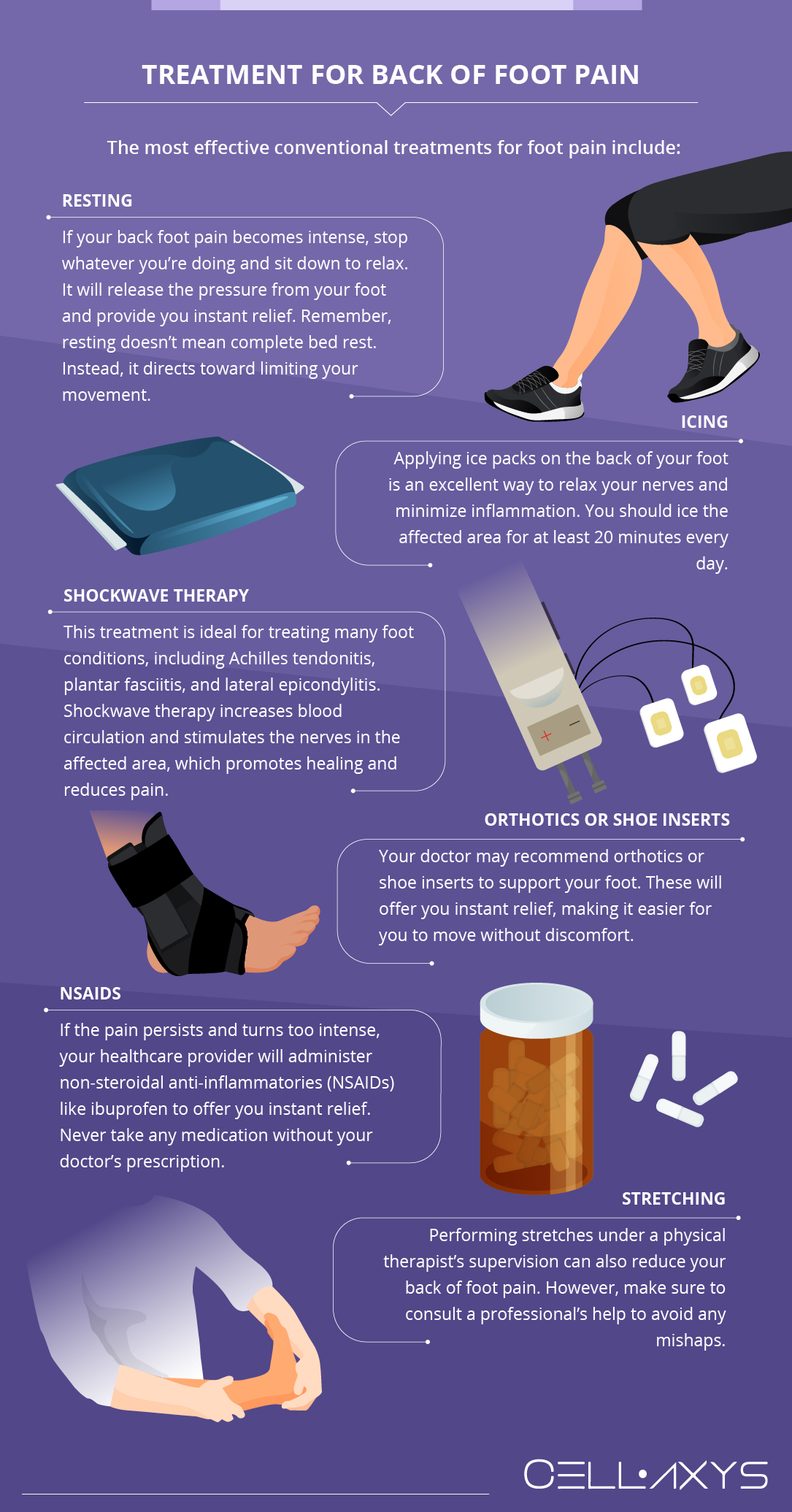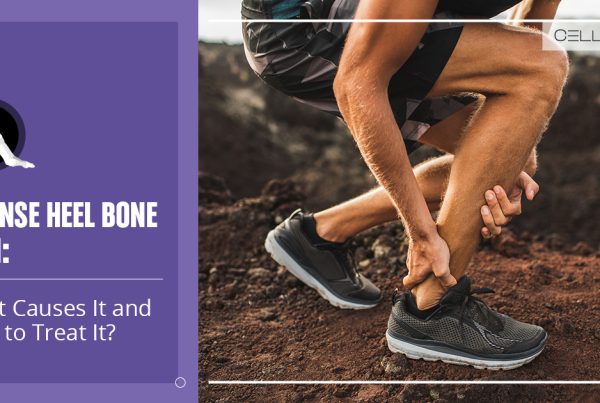Published on: April 3, 2024 | Updated on: January 18, 2025
If you spend most of your day on foot, you can’t afford to have pain in any side of your foot, right? But no matter how hard you try to avoid injuries, some factors can cause mild or stabbing pain in the back of your foot. Of course, this makes it hard for you to continue your daily life like before.
Back of foot pain can occur due to many reasons. It can be Achilles tendonitis, heel spur, Sever’s disease, or an external trauma. Mild cases of back foot pain can be easily resolved at home with heating or icing, shockwave therapy, orthotics, stretches, and more.
If the pain persists for weeks and interrupts your normal life, you should consult a professional healthcare provider. They will diagnose your issue and may recommend surgery as a last resort.
However, surgery is not your only option for persistent back of foot pain. You can opt for regenerative medicine-based methods, i.e., cell-based and platelet-rich plasma (PRP) therapy, as surgical alternatives.
Causes of Back of Foot Pain
Back foot pain, or posterior heel pain, results from multiple reasons, including:
Calcaneal Apophysitis (Sever’s Disease)
Sever’s disease is a common cause of back of foot pain among children and adolescents between 8 to 14 years of age. Children who perform extensive tasks daily or participate in sports are more likely to develop this condition.
The calcaneal apophysis refers to the heel bones’ growth plate area. When this part bears excessive stress, it becomes irritated and inflamed. The affected area may feel bruised, causing pain when you put pressure on it.
Children with sever’s disease experience pain in one or both sides of the foot.
Achilles Tendonitis
Achilles tendonitis is the inflammation of the Achilles tendon in the back of the calf due to excessive strain. It is a recurring cause of back foot pain in adults, limiting the range of motion and making walking and standing uncomfortable.
Patients with Achilles tendonitis experience tightness in their calf. Some people may also suffer from redness, swelling, or heat in the back of the foot.
Haglund’s Deformity (Pump Bump)
Hugland’s deformity refers to a “pump bump,” an abnormal bony heel spur in the back of the foot near the Achilles tendon’s insertion point. The soft tissues in the affected area become more inflamed and irritated due to friction from rigid footwear.
Haglund’s deformity is also known as retrocalcaneal exostosis, a common cause of back of foot pain in middle-aged females. It can also affect males in some instances.
The bony enlargement requires immediate treatment, or it may become more visible and worse over time.
Achilles Tendon Bursitis
Bursitis is inflammation in the bursae; fluid-filled sacs cushion the muscles, ligaments, and tendons by reducing friction. When they become inflamed, you may feel intense pain in the back of your foot.
Achilles tendon bursitis or retrocalcaneal bursitis is the inflammation in the bursa between the heel bone and the Achilles tendon. It results from repetitive irritation and stress on the bursa due to constant running or jumping. The condition may also occur due to friction from rigid footwear.
Besides back of foot pain, Achilles tendon bursitis leads to redness, swelling, and achy pain, especially when flexing or moving the foot.
Treatment for Back of Foot Pain

Back of foot pain is easily manageable with conservative treatments, depending on the diagnosis. However, if nothing works, your doctor may suggest a surgical procedure. You can prevent it through orthobiologic methods: cell-based therapies and platelet-rich plasma (PRP).
Conventional Methods
The most effective conventional treatments for foot pain include:
- Resting. If your back foot pain becomes intense, stop whatever you’re doing and sit down to relax. It will release the pressure from your foot and provide you instant relief. Remember, resting doesn’t mean complete bed rest. Instead, it directs toward limiting your movement.
- Icing. Applying ice packs on the back of your foot is an excellent way to relax your nerves and minimize inflammation. You should ice the affected area for at least 20 minutes every day.
- Shockwave Therapy. This treatment is ideal for treating many foot conditions, including Achilles tendonitis, plantar fasciitis, and lateral epicondylitis. Shockwave therapy increases blood circulation and stimulates the nerves in the affected area, which promotes healing and reduces pain.
- Orthotics or Shoe Inserts. Your doctor may recommend orthotics or shoe inserts to support your foot. These will offer you instant relief, making it easier for you to move without discomfort.
- NSAIDs. If the pain persists and turns too intense, your healthcare provider will administer non-steroidal anti-inflammatories (NSAIDs) like ibuprofen to offer you instant relief. Never take any medication without your doctor’s prescription.
- Stretching. Performing stretches under a physical therapist’s supervision can also reduce your back of foot pain. However, make sure to consult a professional’s help to avoid any mishaps.
Orthobiologic Methods
If the pain persists, you can treat it with less painful and non-invasive regenerative medicine methods. At CELLAXYS, our board-certified surgeons perform cell-based and platelet-rich plasma (PRP) therapy to treat several musculoskeletal issues.
Both are outpatient procedures, meaning you can go home right after the treatment. The surgeon extracts the patient’s own cells or tissues in both methods, so they have a lower complication rate than surgery.
Cell-based Therapies
Also known as stem cell therapy, cell-based therapies involve replacing the patient’s damaged cells with healthy ones to promote healing. Depending on the area from where the cells are extracted, cell-based therapies are of two types: Minimally Manipulated Adipose Tissue Transplant (MMAT) and Bone Marrow Concentrate (BMAC).
MMAT is when the cells are extracted from the adipose (fat) tissues, and BMAC is when the surgeon harvests highly concentrated cells from the bone marrow. Both methods take about 1.5 to 2 hours to complete.
PRP Therapy
In PRP, the surgeon takes the patient’s blood sample, separates platelets from it, and reinjects them into the injury site. Platelets are the healing components of our body, performing three main functions in the case of an injury.
They release 10 growth factors in the blood, attract healthy cells, and produce web-like scaffolding called fibrin. These characteristics support new cell and tissue development to help the body recover faster.
PRP takes about 45 minutes to complete. It has been a popular treatment for sports, orthopedic, and spine-related injuries for over a decade. Patients who undergo orthobiologic treatment for back of foot pain report a short recovery period with little to no discomfort.
Sources
Footnotes
- Menz HB, Dufour AB, Riskowski JL, Hillstrom HJ, Hannan MT. Foot posture, foot function and low back pain: the Framingham Foot Study. Rheumatology. 2013;52(12):2275-82.
- Mølgaard C, Lundbye-Christensen S, Simonsen O. High prevalence of foot problems in the Danish population: a survey of causes and associations. The foot. 2010;20(1):7-11.
- Hendrix CL. Calcaneal apophysitis (Sever disease). Clinics in podiatric medicine and surgery. 2005;22(1):55-62.
- DeMaio M, Paine R, Drez DJ. Achilles tendonitis. Orthopedics. 1995;18(2):195-204.
- Stephens MM. Haglund’s deformity and retrocalcaneal bursitis. Orthopedic Clinics of North America. 1994;25(1):41-6.
- Del Toro D, Nelson PA. Guiding treatment for foot pain. Physical Medicine and Rehabilitation Clinics. 2018;29(4):783-92.
References
- Achilles tendinitis. MedlinePlus. Accessed 11/4/2023.
- Heel Pain. Cleveland Clinic. Accessed 11/4/2023.
- Heel Pain Causes and Treatment. Verywell Health. Accessed 11/4/2023.
CELLAXYS does not offer Stem Cell Therapy as a cure for any medical condition. No statements or treatments presented by Cellaxys have been evaluated or approved by the Food and Drug Administration (FDA). This site contains no medical advice. All statements and opinions are provided for educational and informational purposes only.
Dr Pejman Bady
Author
Dr. Pejman Bady began his career over 20 years ago in Family/Emergency Medicine, working in fast-paced emergency departments in Nevada and Kansas. He has served the people of Las Vegas as a physician for over two decades. Throughout this time, he has been met with much acclaim and is now the head of Emergency Medical Services in Nye County, Nevada. More about the doctor on this page.
Dr Pouya Mohajer
Contributor
Pouya Mohajer, M.D. is the Director of Spine and Interventional Medicine for CELLAXYS: Age, Regenerative, and Interventional Medicine Centers. He has over 20 years of experience in pain management, perioperative medicine, and anesthesiology. Dr. Mohajer founded and is the Medical Director of Southern Nevada Pain Specialists and PRIMMED Clinics. He has dedicated his career to surgical innovation and scientific advancement. More about the doctor on this page.









